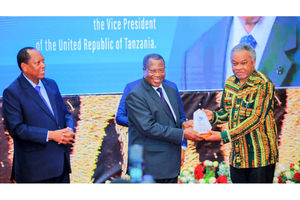Cross breeding technology from US and Brazil to transform Tanzania’s livestock sector

Dodoma. Livestock keepers stand a chance to improve their productivity following the inception of a well-researched cross breading technology from United States and Brazil into the local market, thanks to Urus Tanzania, part of URUS Global, a prominent organization specialized in animal genetics, dairy and beef cattle breeding.
The newly introduced cross-breeding technology that uses semen sourced from US and Brazil offer high yields, which is crucial for maximizing productivity and profitability, according to Edson Mfuru, URUS Tanzania country manager.
“The semen have been tested and proven to deliver superior performance in terms of both quantity and quality of produce’” adds Edson
Although Tanzania ranks the second in terms of cattle population in Africa, contribution of livestock sector into the national income is not enormous, as livestock-related activities contribute only 27 percent of the Agricultural Sector contribution to the economy and 7.1 percent to Tanzania’s GDP in particular; with sector growth at 5 percent (NBS 2020).
The growth largely reflects increases in livestock numbers, rather than productivity gains. The low contribution of livestock in the economy is attributed to many factors, such as animal breeds with low productivity, presence of livestock diseases among other factors.
The country manager noted that while local breeds produce an average of 1-5 litres of milk per day, while breeds resulted from cross breading using semen sourced from US and Brazil can produce 15-25 litres per day and thus ensuring profitability for livestock keepers adding that while local breeds can offer up to a maximum of 200kgs of meat, cross breeds can offer up to 1000kgs.
“Cross bred cattle/improved breeds like Girolando are often bred for specific traits that result in higher milk production, or more meat per animal and they also grow faster and reach market size more quickly, reducing the time and resources needed to raise them,” he explained.
He further noted that the hybrid varieties are often more resistant to common diseases and parasites, reducing the need for medical treatments and associated costs adding that increased resistance leads to lower mortality rates, ensuring a more stable and predictable production output.
“Crossbreeds like Girolando, are typically bred to convert feed into body mass more efficiently, meaning less feed is needed to produce the same amount of meat or milk. Improved feed conversion reduces overall feed costs, which are a significant expense in livestock farming,” he added.
Mr. Mfuru admitted that Urus Tanzania is currently supporting livestock keepers across Tanzania with advanced crossbreeding programs and other agricultural services and with foot prints in Kilimanjaro, Arusha, Tanga, Iringa, Njombe, Mbeya and Kagera.
“While our primary presence is in the above-mentioned regions, we are dedicated to reaching livestock keepers wherever they are in Tanzania. Our goal is to ensure that every livestock keeper in Tanzania, regardless of their location, has access to the best possible support and resources to improve their livestock management practices. We are continually working to expand our reach and improve our services to meet the needs of all farmers,” he said.





